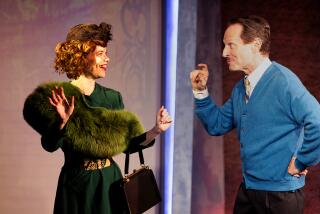The Craft: How Adam Stockhausen came up with Cold War settings for ‘Bridge of Spies’
- Share via
For 2014’s “The Grand Budapest Hotel,” production designer Adam Stockhausen won his first Oscar for creating a pre-World War II Europe tinged with rosy pink nostalgia. For this year’s Cold War thriller “Bridge of Spies,” he rebuilt the Berlin Wall with gray mortar against even grayer skies.
Stockhausen’s first film with director Steven Spielberg is inspired by the true story of insurance lawyer James Donovan, called upon to defend Soviet spy Rudolf Abel in U.S. court, then exchange him for two American prisoners, a pilot and student Frederic Pryor.
SIGN UP for the free Indie Focus movies newsletter >>
Stockhausen relied on locations across the U.S., Germany and Poland to create a complex international backdrop for a story about men who built bridges while nations built walls.
What were your initial conversations with Spielberg and his cinematographer Janusz Kaminski?
We talked about references that were important to Steven, but we also looked at a lot of the historical material. We were looking through thousands and thousands of images and videos of the wall construction and that period in Berlin. And we looked together at “The Spy Who Came in From the Cold.” We made a plan, and we said, “Start in Berlin.” And we knew we wanted to shoot there at the real [Glienicke] Bridge. You can see it on Google, so we knew what it looked like.
How did you find a location that resembled historic East Berlin?
I was working with the location manager for Studio Babelsberg, and his name is Markus Bensch. And he and I were driving all over the east German countryside looking for towns that still had this severely damaged and unrenovated look to them, and we just weren’t finding it. He had a photograph from 20 years earlier of this town in Poland, the most beautiful street, the street that we ended up shooting for the scene where Pryor’s riding his bicycle down the length of the wall as it’s being built. We thought, surely this is gone by now, but just for fun — it’s like a 41/2-hour drive — let’s go and just see. And we went out there, and there it was. It’s spelled Wroc¿aw, but it’s pronounced “Vratslav,” and it used to be called Breslau. It used to be a town in eastern Germany, and then it was remapped to become part of Poland after the Second World War. And that whole section of eastern Germany — well, now Poland — has these beautiful towns with architecture that dates back into the 1500s. Magnificent buildings.
What did you film there?
It was really all of East Germany. Not all, but the scenes where you see the wall being built, the scenes where you see Pryor being arrested, [the scenes] where Donovan is in the train, and he looks out the window, and he sees the family trying to cross the wall, and they’re shot. And Checkpoint Charlie was there. The town allowed us to do quite a bit of construction and build a lot of scenery for those scenes as well.
Where did you shoot the dismal prison scenes?
There’s this prison in [former] East Berlin. And this place had been a Russian prison right after the Second World War. And then in the 1950s, the Russians gave it back to the East Germans, and then it was a Stasi prison until the wall fell. And it was called the Hohenschönhausen. Anyway, it’s a museum now. It has this underground area that was the old Russian prison, and so we put the Russian prison scenes there, and we used the upstairs area for the scenes where Donovan was held by the East German government. And I hope that it felt true, because it kind of was true.
Did you build a model U-2 spy plane?
We worked with the Air Force, and so those U-2s that you see are real. So when you see it takeoff, that’s an actual U-2. We made the camera, and we made the cockpit. You know, the planes exist, but most of the instrumentation isn’t the same as it was in this time period. It’s a bit of a detective job figuring out exactly what each little instrument was and did when you’re not a pilot yourself. And so we had the actual U-2 pilots looking at our cockpit and trying to help us get everything in the right place and make sure that the instruments all made sense and were the appropriate ones, because we really wanted every dial and switch to be the right thing.
More to Read
The biggest entertainment stories
Get our big stories about Hollywood, film, television, music, arts, culture and more right in your inbox as soon as they publish.
You may occasionally receive promotional content from the Los Angeles Times.










